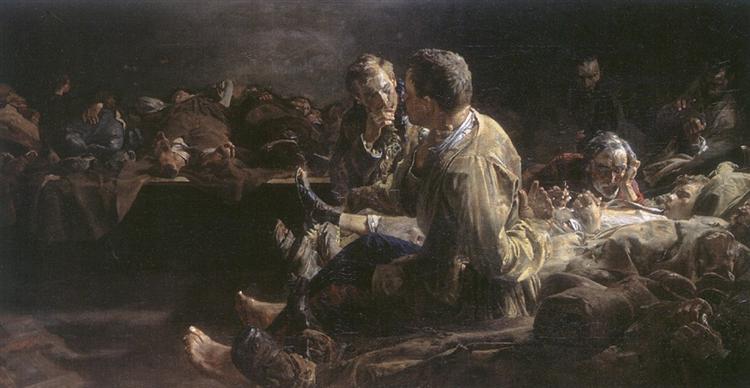Description
The painting "Death en Deported to Siberia" by Jacek Malczewski is an emblematic work that encapsulates the anguish and suffering of the Poles in a time of historical adversity. Made in 1914, this work goes into the dark theme of deportations, a painful process that marks a nation and its individuals, revealing the depth of human pain through a visual language loaded with symbolism and emotion.
From the first glance, the composition of the work, although shocking in its simplification, gives an immense space to the drama of the scene. In the center, a group of deportees is displayed, represented almost sculptorically, which highlights their humanity against the brutal indifference of the tragedy that surrounds them. Malczewski, a master of Polish regionalist symbolism and art, manages to condense in this painting An echo of despair that illuminates its pale and desolate figures, creating a strong contrast to the gloomy landscape that overwhelms them.
The use of color is one of the distinctive characteristics of this painting. Dark and cold tones prevail, evoking sensations of sadness and desolation. Shadows loom over those deported, suggesting not only the imminent physical death, but also the loss of hope. Malczewski uses color as a means to transmit the psychology of its characters; Demacred faces contrast with the earthly tones of the landscape, which reinforces the sensation of isolation and hopelessness.
The characters in painting are at the same time archetypes and individual representations of human suffering. The figure of death, which is granted an almost spectral presence, is insinuated in the upper corner, a reminder of the unavoidable destination that awaits the deportees. This resource to personify death emphasizes the fatality that lurks to humanity, a recurring element in the work of Malczewski, who during his career explored themes of tragedy, heroism and suffering with a psychological deepening that transcends the mere visual representation.
Throughout Malczewski's career, his style evolved, but the essence of his commitment to the human condition remains constant. The painting "Death on the route of deportees to Siberia" reflects not only its technical ability, but also a deep sense of empathy. In this work, echoes from other painters of their time can be observed that discussed issues of suffering and collective suffering, such as Francisco de Goya in their own representations of war and oppression.
The milestones of Polish history, conflicts and moments of historical pain, such as deportations to Siberia, are scenarios that allow Malczewski to explore the tragedy, which gives his work a deeply emotional and reflective tone. His creative process is imbued with a sense of responsibility for his history and his nation, causing "death on the route of deportees to Siberia" not only a representation of a time in time, but a timeless comment on human resistance to the adversity.
When observing this work, it becomes clear that Malczewski not only seeks to reflect suffering, but also invites a broader reflection on the struggle for dignity and collective memory. The "Death on the Deported Route to Siberia" remains a visual testimony of human pain, a work that transcends its time and space to resonate with each spectator who faces its disturbing images. Art, in this case, stands not only as a means of expression, but also as a vehicle of memory and claim.
KUADROS ©, a famous paint on your wall.
Hand-made oil painting reproductions, with the quality of professional artists and the distinctive seal of KUADROS ©.
Art reproduction service with satisfaction guarantee. If you are not completely satisfied with the replica of your painting, we refund your money 100%.

